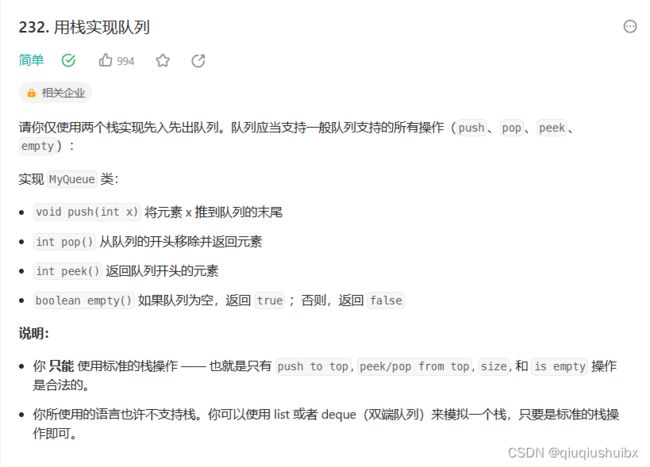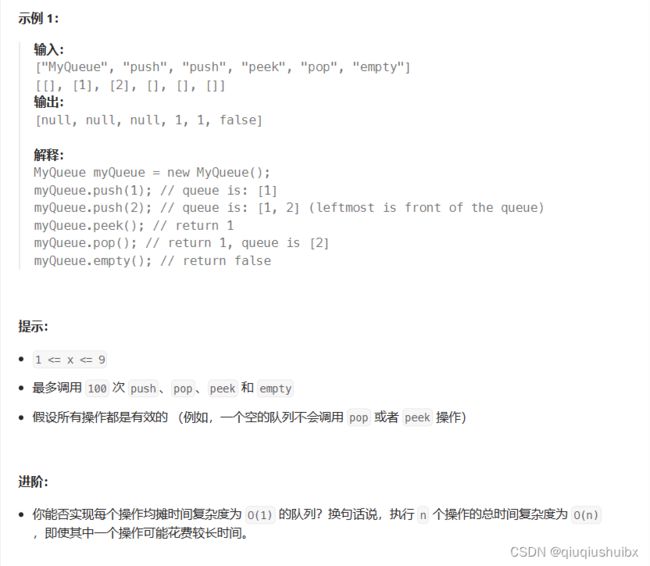代码随想录 Day8 栈(FILO)与队列(FIFO) LeetCode T232 用栈实现队列 LeetCodeT225 用队列实现栈
题目详细思路来自于:代码随想录 (programmercarl.com)
栈和队列都是大家不陌生的数据结构,我们之前的栈和队列一般是用数组或链表来实现的 ,
这里我们给出实现方式,用于帮助更好的理解.
1.用链表实现栈
/* 基于链表实现的栈 */
class LinkedListStack {
private ListNode stackPeek; // 将头节点作为栈顶
private int stkSize = 0; // 栈的长度
public LinkedListStack() {
stackPeek = null;
}
/* 获取栈的长度 */
public int size() {
return stkSize;
}
/* 判断栈是否为空 */
public boolean isEmpty() {
return size() == 0;
}
/* 入栈 */
public void push(int num) {
ListNode node = new ListNode(num);
node.next = stackPeek;
stackPeek = node;
stkSize++;
}
/* 出栈 */
public int pop() {
int num = peek();
stackPeek = stackPeek.next;
stkSize--;
return num;
}
/* 访问栈顶元素 */
public int peek() {
if (size() == 0)
throw new IndexOutOfBoundsException();
return stackPeek.val;
}
/* 将 List 转化为 Array 并返回 */
public int[] toArray() {
ListNode node = stackPeek;
int[] res = new int[size()];
for (int i = res.length - 1; i >= 0; i--) {
res[i] = node.val;
node = node.next;
}
return res;
}
}2.用数组实现栈
class ArrayStack {
private ArrayList stack;
public ArrayStack() {
// 初始化列表(动态数组)
stack = new ArrayList<>();
}
/* 获取栈的长度 */
public int size() {
return stack.size();
}
/* 判断栈是否为空 */
public boolean isEmpty() {
return size() == 0;
}
/* 入栈 */
public void push(int num) {
stack.add(num);
}
/* 出栈 */
public int pop() {
if (isEmpty())
throw new IndexOutOfBoundsException();
return stack.remove(size() - 1);
}
/* 访问栈顶元素 */
public int peek() {
if (isEmpty())
throw new IndexOutOfBoundsException();
return stack.get(size() - 1);
}
/* 将 List 转化为 Array 并返回 */
public Object[] toArray() {
return stack.toArray();
}
} 3.两种实现的优缺点
3.1 用数组实现栈的优缺点
在基于数组的实现中,入栈和出栈操作都是在预先分配好的连续内存中进行,具有很好的缓存本地性,因此效率较高。然而,如果入栈时超出数组容量,会触发扩容机制,导致该次入栈操作的时间复杂度变为 ().
3.2 用链表实现栈的优缺点
在链表实现中,链表的扩容非常灵活,不存在上述数组扩容时效率降低的问题。但是,入栈操作需要初始化节点对象并修改指针,因此效率相对较低。不过,如果入栈元素本身就是节点对象,那么可以省去初始化步骤,从而提高效率。
4. 用链表实现队列
class LinkedListQueue {
private ListNode front, rear; // 头节点 front ,尾节点 rear
private int queSize = 0;
public LinkedListQueue() {
front = null;
rear = null;
}
/* 获取队列的长度 */
public int size() {
return queSize;
}
/* 判断队列是否为空 */
public boolean isEmpty() {
return size() == 0;
}
/* 入队 */
public void push(int num) {
// 尾节点后添加 num
ListNode node = new ListNode(num);
// 如果队列为空,则令头、尾节点都指向该节点
if (front == null) {
front = node;
rear = node;
// 如果队列不为空,则将该节点添加到尾节点后
} else {
rear.next = node;
rear = node;
}
queSize++;
}
/* 出队 */
public int pop() {
int num = peek();
// 删除头节点
front = front.next;
queSize--;
return num;
}
/* 访问队首元素 */
public int peek() {
if (size() == 0)
throw new IndexOutOfBoundsException();
return front.val;
}
/* 将链表转化为 Array 并返回 */
public int[] toArray() {
ListNode node = front;
int[] res = new int[size()];
for (int i = 0; i < res.length; i++) {
res[i] = node.val;
node = node.next;
}
return res;
}
}5.用数组实现队列
你可能会发现一个问题:在不断进行入队和出队的过程中, front 和 rear 都在向右移动, 当它们到达数组尾部时就无法继续移动了。为解决此问题,我们可以将数组视为首尾相接的“环形数组”。对于环形数组,我们需要让 front 或 rear 在越过数组尾部时,直接回到数组头部继续遍历。这种周期性规律可以通过“取余操作”来实现
/* 基于环形数组实现的队列 */
class ArrayQueue {
private int[] nums; // 用于存储队列元素的数组
private int front; // 队首指针,指向队首元素
private int queSize; // 队列长度
public ArrayQueue(int capacity) {
nums = new int[capacity];
front = queSize = 0;
}
/* 获取队列的容量 */
public int capacity() {
return nums.length;
}
/* 获取队列的长度 */
public int size() {
return queSize;
}
/* 判断队列是否为空 */
public boolean isEmpty() {
return queSize == 0;
}
/* 入队 */
public void push(int num) {
if (queSize == capacity()) {
System.out.println(" 队列已满");
return;
}
// 计算尾指针,指向队尾索引 + 1
// 通过取余操作,实现 rear 越过数组尾部后回到头部
int rear = (front + queSize) % capacity();
// 将 num 添加至队尾
nums[rear] = num;
queSize++;
}
/* 出队 */
public int pop() {
int num = peek();
// 队首指针向后移动一位,若越过尾部则返回到数组头部
front = (front + 1) % capacity();
queSize--;
return num;
}
/* 访问队首元素 */
public int peek() {
if (isEmpty())
throw new IndexOutOfBoundsException();
return nums[front];
}
/* 返回数组 */
public int[] toArray() {
// 仅转换有效长度范围内的列表元素
int[] res = new int[queSize];
for (int i = 0, j = front; i < queSize; i++, j++) {
res[i] = nums[j % capacity()];
}
return res;
}
}LeetCode T232 用栈实现队列
题目链接:
232. 用栈实现队列 - 力扣(LeetCode)
题目思路:
我们这里就要用两个栈来实现队列,一个是stackOut,一个是stackIn,in栈负责将要入队的添加进来,但是这时候我们发现出栈的话会和队列的出队顺序相反,所以我们再入栈一次,这样出栈的顺序就颠倒过来啦,也完美的实现队列的基本功能.
注:一定要将In栈的全部元素一起push进Out栈,否则顺序可能会发生变化,这样就影响了正常的出栈功能.
题目代码:
class MyQueue {
Stack stackIn;
Stack stackOut;
public MyQueue() {
stackIn = new Stack<>();
stackOut = new Stack<>();
}
public void push(int x) {
stackIn.push(x);
}
public int pop() {
downStackIn();
return stackOut.pop();
}
public int peek() {
downStackIn();
return stackOut.peek();
}
public boolean empty() {
downStackIn();
return stackOut.isEmpty();
}
public void downStackIn()
{
while(!stackOut.isEmpty())
{
return;
}
while(!stackIn.isEmpty())
{
stackOut.push(stackIn.pop());
}
}
}
/**
* Your MyQueue object will be instantiated and called as such:
* MyQueue obj = new MyQueue();
* obj.push(x);
* int param_2 = obj.pop();
* int param_3 = obj.peek();
* boolean param_4 = obj.empty();
*/ LeetCode T225 用队列实现栈
题目链接:225. 用队列实现栈 - 力扣(LeetCode)
题目思路:
这里我们同样可以用和上一题同样的思路实现,但是为了更有挑战性,我们决定用一个队列来实现栈,假设我们入队元素是123,此时我们需要的出队元素应该是3,那么我们该如何操作呢,其实,我们只需要让前两个元素重新入队,这样第一个出队的元素就是3了,其实就是前size()-1个元素重新入队,就实现了出栈的操作
这里我使用的是deque,这个类可以实现两天的操作,就是比queue多了两头操作的一些方法.
题目代码:
class MyStack {
Deque que1;
public MyStack() {
que1 = new ArrayDeque<>();
}
public void push(int x) {
que1.addLast(x);
}
public int pop() {
int tmp = que1.size()-1;
while(tmp>0)
{
que1.addLast(que1.peekFirst());
que1.pollFirst();
tmp--;
}
return que1.pollFirst();
}
public int top() {
return que1.peekLast();
}
public boolean empty() {
return que1.isEmpty();
}
}
/**
* Your MyStack object will be instantiated and called as such:
* MyStack obj = new MyStack();
* obj.push(x);
* int param_2 = obj.pop();
* int param_3 = obj.top();
* boolean param_4 = obj.empty();
*/ 


